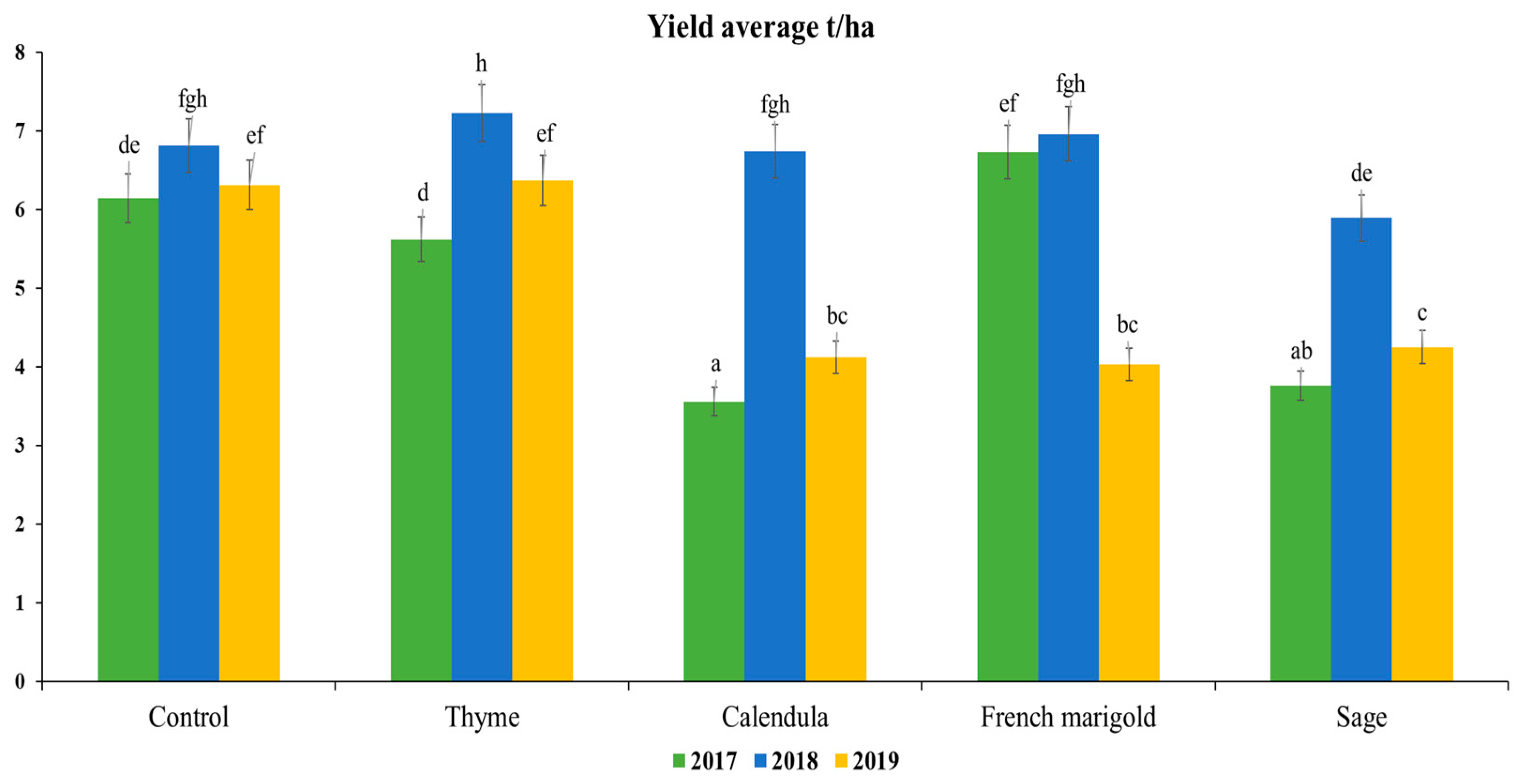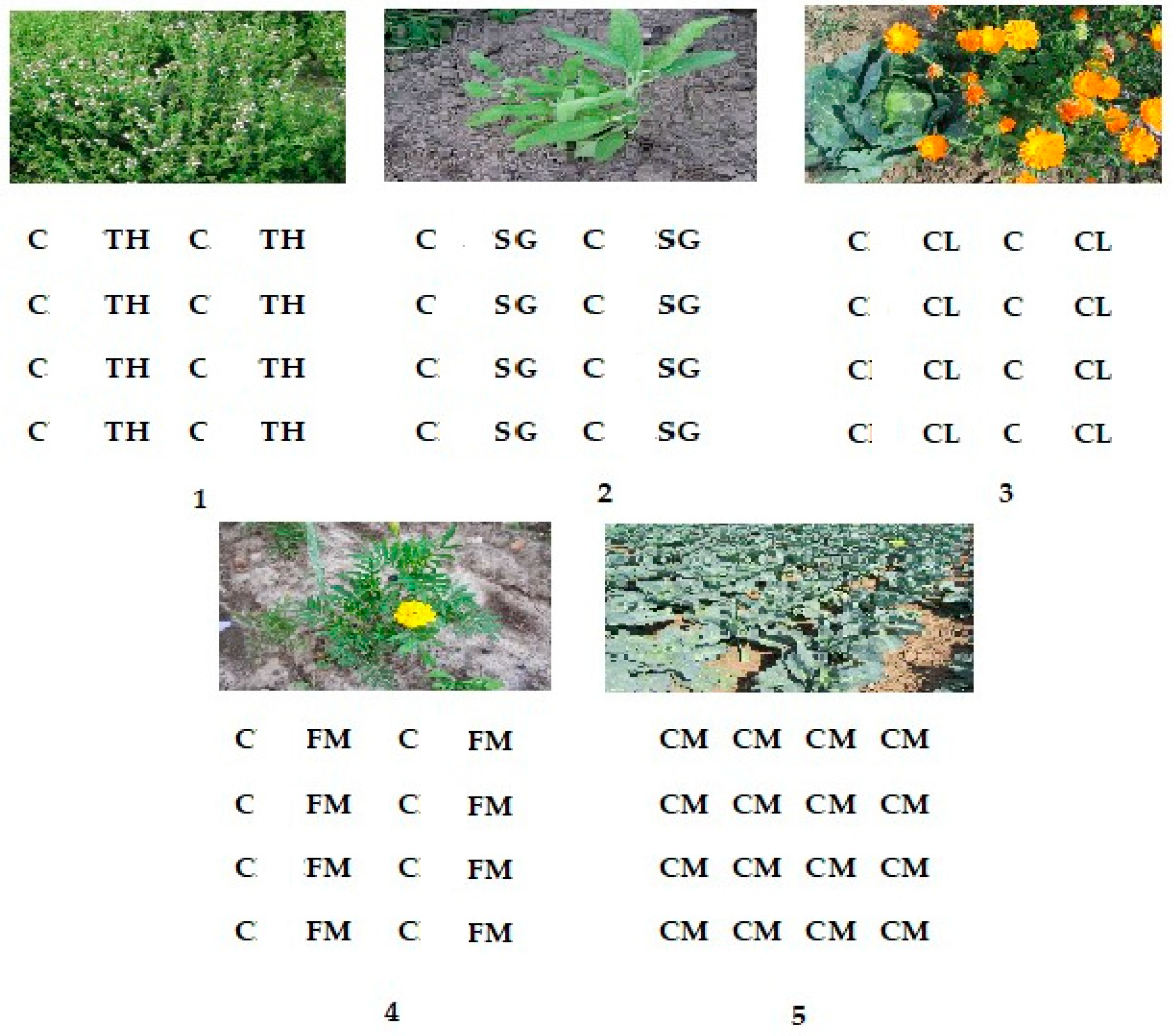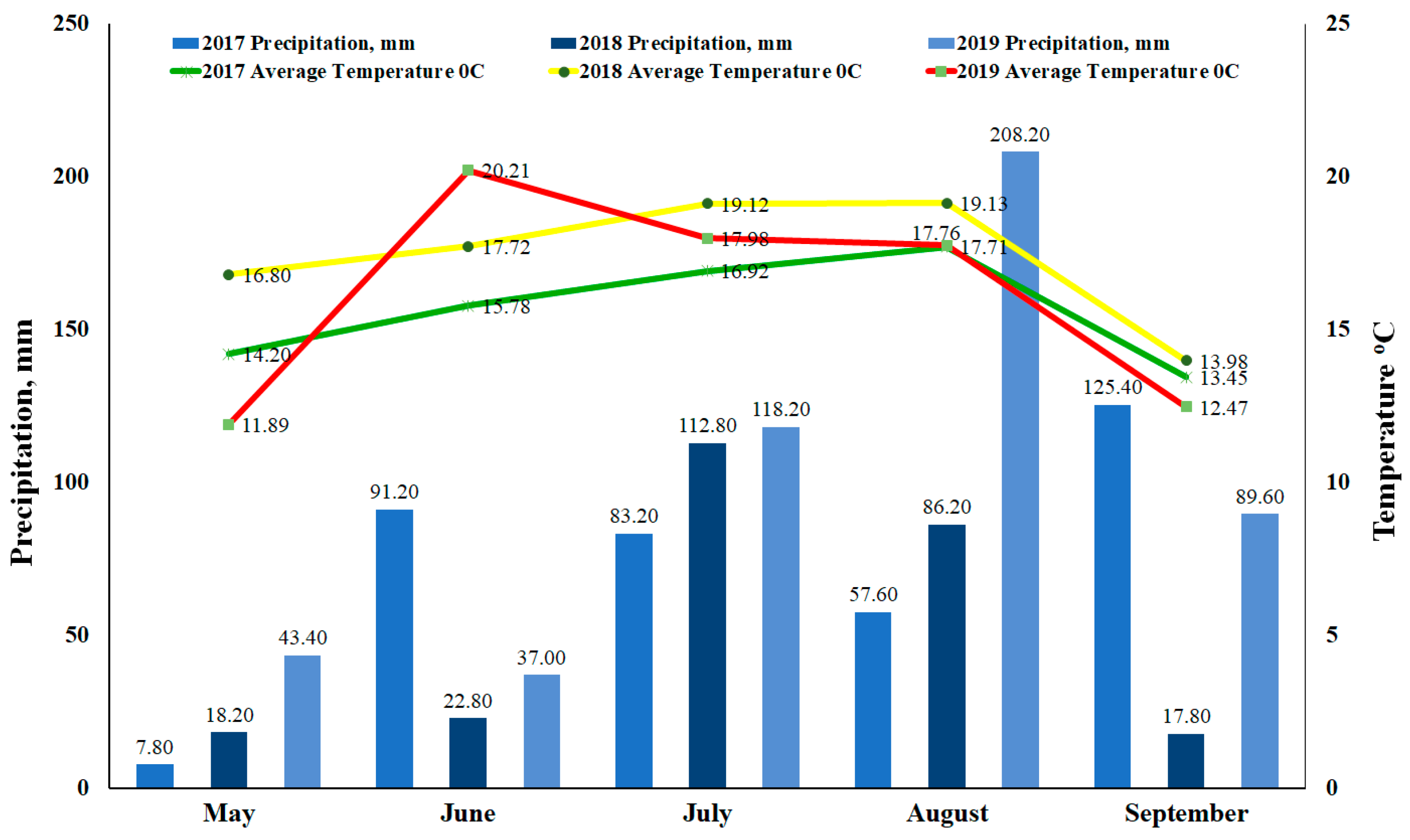Effect of White Cabbage Intercropping with Aromatic Plant on Yield, Mineral and Biochemical Composition
Abstract
1. Introduction
2. Results
2.1. Cabbage Yield
2.2. Mineral Composition
2.3. Dry Matter and Ascorbic Acid
2.4. Sugar Content and Nitrates Quantity
2.5. Glucosinolates
3. Discussion
4. Materials and Methods
4.1. Field Trial
4.2. Plant Material
4.3. Analysis
4.4. Statistical Analysis
4.5. Meteorological Data
5. Conclusions
Author Contributions
Funding
Institutional Review Board Statement
Informed Consent Statement
Data Availability Statement
Conflicts of Interest
References
- Manasa, P.; Ram, M.S.; Maitra, S.; Shankar, A.; Gaikwad, D.J. A review on productivity of maize intercropping systems. Indian J. Nat. Sci. 2020, 11, 28617–28623. [Google Scholar]
- Yarou, B.B.; Komlan, F.A.; Tossou, E.; Mensah, A.C.; Simon, S.; Verheggen, F.J.; Francis, F. Efficacy of basil-cabbage intercropping o control insect pests in Benin, West Africa. Commun. Agric. Appl. Biol. Sci. 2017, 82, 157–166. [Google Scholar]
- Jankowska, B.; Poniedzialek, M.; Jedrszczyk, E. Effect of intercropping white cabbage with French marigold (Tagetes patula nana L.) and pot marigold (Calendula officinalis L.) on the colonization of plants by pest insects. Folia Hortic. 2009, 21, 95–103. [Google Scholar] [CrossRef]
- Guvenc, I.; Yildirim, E. Increasing productivity with intercropping systems in cabbage production. J. Sustain. Agric. 2006, 28, 29–44. [Google Scholar] [CrossRef]
- Garrity, D.P.; Akinnifesi, F.K.; Ajayi, O.C.; Weldesemayat, S.G.; Mowo, J.G.; Kalinganire, A.; Larwanou, M.; Bayala, J. Evergreen Agriculture: A robust approach to sustainable food security in Africa. Food Secur. 2010, 2, 197–214. [Google Scholar] [CrossRef]
- Carrillo-Reche, J.; Le Noc, T.; Van Apeldoorn, D.F.; Juventia, S.D.; Westhoek, A.; Shanmugam, S.; Kristensen, H.L.; Hondebrink, M.; Himanen, S.J.; Kivijärvi, P.; et al. Finding guidelines for cabbage intercropping systems design as a first step in a meta-analysis relay for vegetables. Agric. Ecosyst. Environ. 2023, 354, 108564. [Google Scholar] [CrossRef]
- Lepse, L.; Zeipiņa, S. Increasing the sustainability of vegetable crops production by using intercropping. Agron. Res. 2023, 21, 494–503. [Google Scholar]
- Arenas-Salazar, A.P.; Schoor, M.; Parra-Pacheco, B.; García-Trejo, J.F.; Torres-Pacheco, I.; Feregrino-Pérez, A.A. Intercropping Systems to Modify Bioactive Compounds and Nutrient Profiles in Plants: Do We Have Enough Information to Take This as a Strategy to Improve Food Quality? A Review. Plants 2024, 13, 194. [Google Scholar] [CrossRef]
- dos Santos Viana, C.; de Almeida Guimarães, M.; Neto, H.D.S.L.; Neto, B.P.L.; Sampaio, Í.M.G.; de Araújo Hendges, A.R.A.; da Silva Rabelo, J. Intercropping arugula with aromatic condiment species affords better yields, biological efficiency and financial return. Res. Soc. Dev. 2021, 10, 3. [Google Scholar]
- Kim, J.J.; John, K.M.M.; Hae-Kyung, M.; Jin, K.; Enkhtaivan, G.; Kim, D.H. Morphological and biochemical variation of Chinese cabbage (Brassica rapa spp. Pekinensis) cultivated using different agricultural practices. J. Food Compos. Anal. 2014, 36, 12–23. [Google Scholar] [CrossRef]
- Paut, R.; Garreau, L.; Ollivier, G.; Sabatier, R.; Tchamitchian, M. A global dataset of experimental intercropping and agroforestry studies in horticulture. Sci. Data 2024, 11, 5. [Google Scholar] [CrossRef] [PubMed]
- Khanum, M.; Bazzaz, M.; Ahmed, B.; Huda, M.; Hossain, M. Intercropping of cabbage with maize. Bangladesh Agron. J. 2020, 22, 115–120. [Google Scholar] [CrossRef]
- Stein, S.; Hartung, J.; Möller, K.; Zikeli, S. The effects of Leguminous living mulch intercropping and its growth management on organic cabbage yield and biological nitrogen fixation. Agronomy 2022, 12, 1009. [Google Scholar] [CrossRef]
- Wondimkun, D. Role of intercropping some aromatic and medicinal plants with fruit vegetables crops, a Review. Glob. Acad. J. Agric. Biosci. 2022, 4, 22–30. [Google Scholar]
- Juventia, S.D.; Ditzler, L.L.E.; Rossing, W.A.H.; van Apeldoorn, D.F. Intercropping Promotes both Agronomic and Ecological Aims: The Case of Organic Strip Cropped Cabbage (Brassica oleracea L.). In Proceedings of the European Conference on Crop Diversification 2019, Budapest, Hungary, 18–21 September 2019; Messean, A., Drexler, D., Heim, I., Paresys, L., Stilmant, D., Willer, H., Eds.; First European Conference on Crop Diversification: Book of Abstracts; INRA. pp. 163–164. [Google Scholar]
- Francisco, M.; Tortosa, M.; Martinez-Ballesta, M.C.; Velasco, P.; Garcia-Viguera, C. Nutritional and phytochemical value of Brassica crops from the agri-food perspective. Ann. Appl. Biol. 2017, 170, 273–285. [Google Scholar] [CrossRef]
- Mezzetti, B.; Biondi, F.; Balducci, F.; Capocasa, F.; Mei, E.; Vagnoni, M.; Visciglio, M.; Mazzoni, L. Variation of Nutritional Quality Depending on Harvested Plant Portion of Broccoli and Black Cabbage. Appl. Sci. 2022, 12, 6668. [Google Scholar] [CrossRef]
- Park, S.; Arasu, M.V.; Lee, M.K.; Chun, J.H.; Seo, J.M.; Al-Dhabi, N.A.; Kim, S.J. Analysis and metabolite profiling of glucosinolates, anthocyanins and free amino acids in inbred lines of green and red cabbage (Brassica oleracea L.). LWT 2014, 58, 203–213. [Google Scholar] [CrossRef]
- Tribulato, A.; Branca, F.; Ragusa, L.; Lo Scalzo, R.; Picchi, V. Survey of health-promoting compounds in seeds and sprouts of Brassicaceae. Acta Hortic. 2013, 1005, 323–330. [Google Scholar] [CrossRef]
- Wermter, N.S.; Rohn, S.; Hanschen, F.S. Seasonal Variation of Glucosinolate Hydrolysis Products in Commercial White and Red Cabbages (Brassica oleracea var. capitata). Foods 2020, 9, 1682. [Google Scholar] [CrossRef]
- Pokluda, R. Nutritional quality of Chinese cabbage from integrated culture. Hortic. Sci. 2008, 35, 145–150. [Google Scholar] [CrossRef]
- Hounsome, N.; Hounsome, B.; Tomos, D.; Edwards-Jones, G. Plant metabolites and nutritional quality of vegetables. J. Food Sci. 2008, 73, R48–R65. [Google Scholar] [CrossRef] [PubMed]
- Aghajanzadeh, T.A.; Watanabe, M.; Tohge, T.; Hawkesford, M.J.; Fernie, A.R.; Hoefgen, R.; De Kok, L.J. Necrotrophic fungal infection affects indolic glucosinolate metabolism in Brassica rapa. Acta Physiol. Plant. 2023, 45, 64. [Google Scholar] [CrossRef]
- Boteva, H.; Turegeldiyev, B.; Aitbayev, T.; Rakhymzhanov, B.; Aitbayeva, A. The influence of biofertilizers and organic fertilizers on productivity, quality and storing of cabbage (Brassica oleracea var. capitata L.) in the South-East of Kazakhstan. Bulg. J. Agric. Sci. 2019, 25, 973–979. [Google Scholar]
- Tanyi, C.; Ngosong, C.; Ntonifor, N. Comparative effects of Piper guineense emulsion and cabbage-tomato intercropping for controlling cabbage pests and improving performance. J. Agric. Ecol. Res. 2017, 13, 1–12. [Google Scholar] [CrossRef]
- Juventia, S.D.; Rossing, W.A.H.; Ditzler, L.; Apeldoorn, D.F. Spatial and genetic crop diversity support ecosystem service delivery: A case of yield and biocontrol in Dutch organic cabbage production. Field Crops Res. 2021, 261, 108015. [Google Scholar] [CrossRef]
- Asare-Bediako, E.; Addo-Quaye, A.A.; Mohammed, A. Control of diamondback moth (Plutella xylostella) on cabbage (Brassica oleracea var capitata) using intercropping with non-host crops. Am. J. Food Technol. 2010, 5, 269–274. [Google Scholar]
- Debra, K.R.; Misheck, D. Onion (Allium cepa) and garlic (Allium sativum) as pest control intercrops in cabbage based intercrop systems in Zimbabwe. IOSR J. Agric. Vet. Sci. 2014, 7, 13–17. [Google Scholar] [CrossRef]
- Gadzekpo, I.; Akhiwu, B.A.; Nyarko, R.A. The effect of intercropping cabbage-cowpea on insects population, diversity and interactions. Sci. J. Biol. Sci. 2020, 1, SJBLS.MS.ID.000516. [Google Scholar]
- Abbes, Z.; Trabelsi, I.; Kharrat, M.; Amri, M. Intercropping with fenugreek (Trigonella foenum-graecum) enhanced seed yield and reduced Orobanche foetida infestation in faba bean (Vicia faba). Biol. Agric. Hortic. 2019, 35, 238–247. [Google Scholar] [CrossRef]
- Iamba, K.; Homband, V. Intercropping of Pak choi (Brassica rapa chinensis) with marigold flower (Tagetes erecta L.) and onion (Allium cepa L.) to control foliar pests. J. Entomol. Zool. 2020, 8, 731–737. [Google Scholar]
- Ulbrich, A.; Kahle, H.; Kramer, P.; Schulz, M. Mentha x piperita volatiles promote Brassica oleracea- a pilot study. Allelopath. J. 2018, 43, 93–104. [Google Scholar] [CrossRef]
- Golijan, J.; Marković, D. The benefits of organic production of medicinal and aromatic plants in intercropping system. Acta Agric. Serb. 2018, 45, 61–761. [Google Scholar] [CrossRef]
- Zhang, Y.; Ham, M.; Song, M.; Tian, J.; Song, B.; Hu, Y.; Zhang, J.; Yao, Y. Intercropping with aromatic plants increased the soil organic matter content and changed the microbial community in a pear orchard. Front. Microbiol. 2021, 12, 616932. [Google Scholar] [CrossRef] [PubMed]
- Šernaitė, L.; Rasiukevičiūtė, N.; Valiuškaitė, A. The extracts of cinnamon and clove as potential biofungicides against strawberry grey mould. Plants 2020, 9, 613. [Google Scholar] [CrossRef] [PubMed]
- Šernaitė, L.; Rasiukevičiūtė, N.; Valiuškaitė, A. Application of plant extracts to control postharvest gray mold and susceptibility of apple fruits to B. cinerea from different plant hosts. Foods 2020, 9, 1430. [Google Scholar] [CrossRef] [PubMed]
- Šernaitė, L.; Rasiukevičiūtė, N.; Dambrauskienė, E.; Viškelis, P.; Valiuškaitė, A. Efficacy of plant extracts and essential oils for biocontrol of strawberry pathogen Botrytis cinerea. Zemdirb. Agric. 2020, 107, 147–152. [Google Scholar] [CrossRef]
- Morkeliūnė, A.; Rasiukevičiūtė, N.; Valiuškaitė, A. Pathogenicity of Colletotrichum acutatum to different strawberry cultivars and anthracnose control with essential oils. Zemdirb. Agric. 2021, 108, 173–180. [Google Scholar] [CrossRef]
- Morkeliūnė, A.; Rasiukevičiūtė, N.; Šernaitė, L.; Valiuškaitė, A. The Use of Essential Oils from Thyme, Sage and Peppermint against Colletotrichum acutatum. Plants 2021, 10, 114. [Google Scholar] [CrossRef]
- Jankowska, B.; Poniedzialek, M.; Jedrszczyk, E. Effect of intercropping carrot (Daucus carota L.) with french marigold (Tagetes patula nana L.) and pot marigold (Calendula officinalis L.) on the occurrence of some pests and quality of carrot yield. Acta Agrobot. 2012, 65, 133–138. [Google Scholar] [CrossRef]
- LST ISO 6557-2:2000; ISO 6557-2:1984 (EN) Fruits, vegetables and derived products — Determination of ascorbic acid content — Part 2: Routine methods. ISO Technical Committees: Geneva, Switzerland, 2023. (In Lithuanian)
- ISO 9167:2019(E); Rapeseed and Rapeseed Meals—Determination of Glucosinolates Content-Method Using High-Performance Liquid Chromatography. ISO Technical Committees: Geneva, Switzerland, 2019.



| Year | Treatment | Percentage (%) | ||||
|---|---|---|---|---|---|---|
| N | P | K | Ca | Mg | ||
| 2017 | CM | 0.1200 a | 0.0160 c | 0.1500 c | 0.0360 b | 0.0086 a |
| CCL | 0.1500 c | 0.0150 b | 0.1400 b | 0.0360 b | 0.0088 b | |
| CFM | 0.1400 b | 0.0170 d | 0.1600 d | 0.0350 a | 0.0090 c | |
| CSG | 0.1600 d | 0.0180 e | 0.1600 d | 0.0360 b | 0.0100 d | |
| CTH | 0.1800 e | 0.0170 d | 0.1300 a | 0.0410 c | 0.0110 e | |
| 2018 | CM | 0.1800 b | 0.0200 d | 0.1700 c | 0.0360 d | 0.0091 d |
| CCL | 0.1600 a | 0.0180 b | 0.1600 b | 0.0350 c | 0.0089 c | |
| CFM | 0.1600 a | 0.0190 c | 0.1700 c | 0.0330 b | 0.0096 e | |
| CSG | 0.1600 a | 0.0170 a | 0.1500 a | 0.0310 a | 0.0083 a | |
| CTH | 0.1600 a | 0.0180 b | 0.1800 d | 0.0410 e | 0.0088 b | |
| Year | Treatment | Dry Matter (%) | Ascorbic Acid (mg/100 g) |
|---|---|---|---|
| 2017 | CM | 6.16 b | 2.80 b |
| CCL | 5.49 a | 2.60 a | |
| CFM | 6.91 d | 2.80 b | |
| CSG | 6.54 c | 2.90 c | |
| CTH | 7.00 e | 5.00 d | |
| 2018 | CM | 6.96 e | 5.81 e |
| CCL | 6.84 d | 5.66 d | |
| CFM | 5.97 a | 4.76 b | |
| CSG | 6.37 b | 4.73 a | |
| CTH | 6.77 d | 5.63 c |
| Treatment | Sugar Content (%) | NO3− (mg/kg) | ||||
|---|---|---|---|---|---|---|
| 2017 | 2018 | 2019 | 2017 | 2018 | 2019 | |
| CM | 4.35 e | 3.81 d | 3.98 e | 1006 b | 1222 b | 476 a |
| CCL | 2.52 a | 3.36 c | 3.77 d | 2139 e | 1089 a | 615 b |
| CFM | 4.17 d | 3.20 b | 3.39 a | 722 a | 1333 c | 1121 e |
| CSG | 3.70 b | 3.18 a | 3.64 c | 1564 c | 1500 d | 1042 d |
| CTH | 3.91 c | 3.35 c | 3.45 b | 1628 d | 1606 e | 983 c |
| Treatment | Glucosinolates (%) | ||
|---|---|---|---|
| 2017 | 2018 | 2019 | |
| CM | 0.38 a | 0.45 c | 0.58 b |
| CCL | 0.67 b | 1.39 e | 0.39 a |
| CFM | 1.12 d | 0.42 c | 0.93 c |
| CSG | 0.77 c | 0.25 b | 1.39 e |
| CTH | 1.24 e | 1.08 d | 1.16 d |
| Year | pH | Organic Materials | Hummus | Organic C | N Total | P2O5 | K2O | Ca | Mg |
|---|---|---|---|---|---|---|---|---|---|
| % | mg/kg | ||||||||
| 2017 | 7.3 | 3.91 | 2.67 | 1.55 | 0.13 | 200 | 150 | 14,908 | 4024 |
| 2018 | 7.2 | 3.60 | 2.38 | 1.38 | 0.12 | 308 | 181 | 4078 | 758 |
| 2019 | 7.1 | 3.22 | 1.95 | 1.13 | 0.12 | 271 | 212 | 10,340 | 2264 |
Disclaimer/Publisher’s Note: The statements, opinions and data contained in all publications are solely those of the individual author(s) and contributor(s) and not of MDPI and/or the editor(s). MDPI and/or the editor(s) disclaim responsibility for any injury to people or property resulting from any ideas, methods, instructions or products referred to in the content. |
© 2024 by the authors. Licensee MDPI, Basel, Switzerland. This article is an open access article distributed under the terms and conditions of the Creative Commons Attribution (CC BY) license (https://creativecommons.org/licenses/by/4.0/).
Share and Cite
Morkeliūnė, A.; Rasiukevičiūtė, N.; Dėnė, L.; Dambrauskienė, E.; Duchovskienė, L.; Valiuškaitė, A. Effect of White Cabbage Intercropping with Aromatic Plant on Yield, Mineral and Biochemical Composition. Plants 2024, 13, 1870. https://doi.org/10.3390/plants13131870
Morkeliūnė A, Rasiukevičiūtė N, Dėnė L, Dambrauskienė E, Duchovskienė L, Valiuškaitė A. Effect of White Cabbage Intercropping with Aromatic Plant on Yield, Mineral and Biochemical Composition. Plants. 2024; 13(13):1870. https://doi.org/10.3390/plants13131870
Chicago/Turabian StyleMorkeliūnė, Armina, Neringa Rasiukevičiūtė, Lina Dėnė, Edita Dambrauskienė, Laisvūnė Duchovskienė, and Alma Valiuškaitė. 2024. "Effect of White Cabbage Intercropping with Aromatic Plant on Yield, Mineral and Biochemical Composition" Plants 13, no. 13: 1870. https://doi.org/10.3390/plants13131870
APA StyleMorkeliūnė, A., Rasiukevičiūtė, N., Dėnė, L., Dambrauskienė, E., Duchovskienė, L., & Valiuškaitė, A. (2024). Effect of White Cabbage Intercropping with Aromatic Plant on Yield, Mineral and Biochemical Composition. Plants, 13(13), 1870. https://doi.org/10.3390/plants13131870






